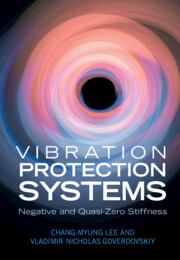Book contents
- Vibration Protection Systems
- Vibration Protection Systems
- Copyright page
- Contents
- Preface
- Acknowledgments
- Glossary
- 1 Vibrations Destroying Human–Machine Systems Inside and Outside
- 2 Vibration Protection Systems with Negative and Quasi-Zero Stiffness
- 3 Modeling of Elastic Postbuckling in Large and Dimensioning the Mechanisms with Negative Stiffness
- 4 The Type and Number Synthesis of Function-Generating Mechanisms
- 5 Dynamics of Systems with Sign-Changing Stiffness
- 6 Dynamics of Systems with Sign-Changing Stiffness
- 7 Dynamics of Systems with Sign-Changing Stiffness
- 8 Methods of Experimental Study of Vibration Protection Systems with Negative and Quasi-Zero Stiffness
- 9 In Harmony with Conventional Vibration Protection Systems
- 10 Development and Use of Vibration Protection Systems with Negative and Quasi-Zero Stiffness
- Index
- References
1 - Vibrations Destroying Human–Machine Systems Inside and Outside
Published online by Cambridge University Press: 29 October 2021
- Vibration Protection Systems
- Vibration Protection Systems
- Copyright page
- Contents
- Preface
- Acknowledgments
- Glossary
- 1 Vibrations Destroying Human–Machine Systems Inside and Outside
- 2 Vibration Protection Systems with Negative and Quasi-Zero Stiffness
- 3 Modeling of Elastic Postbuckling in Large and Dimensioning the Mechanisms with Negative Stiffness
- 4 The Type and Number Synthesis of Function-Generating Mechanisms
- 5 Dynamics of Systems with Sign-Changing Stiffness
- 6 Dynamics of Systems with Sign-Changing Stiffness
- 7 Dynamics of Systems with Sign-Changing Stiffness
- 8 Methods of Experimental Study of Vibration Protection Systems with Negative and Quasi-Zero Stiffness
- 9 In Harmony with Conventional Vibration Protection Systems
- 10 Development and Use of Vibration Protection Systems with Negative and Quasi-Zero Stiffness
- Index
- References
Summary
The infra-low-frequency vibrations are most dangerous and harmful for humans. They affect a person as an operator or passenger of the vehicles and other vibrating machines, and his environment the rest of a day and night. These are longtime and thus devastating effects since human natural frequencies dramatically coincide with forced vibrations of the machines in the same spectra, resulting in permanent broadband resonances. The general and industrial standards regulate exposure time of vibration impacts to humans, since conventional vibration protection systems, to put it mildly, do not quite cope with the functions assigned to them. Moreover, they operate as vibration amplifiers rather than vibration systems just in these frequency spectra. Besides, new potentially hazard vibrations, for example, in the near-zero frequencies appear with advent of the machines of next generation under intensive development, such as high-speed railroad trains for long distances and multiple-purpose helicopters. Fundamentally other design methods and proper technology are required to provide the infra-low-frequency vibration protection of humans inside and outside operating transport vehicles, construction equipment, and other machines, especially since a gap increases between efficiency of the conventional systems and vibration limits required for health, activity, and comfort of humans
- Type
- Chapter
- Information
- Vibration Protection SystemsNegative and Quasi-Zero Stiffness, pp. 1 - 24Publisher: Cambridge University PressPrint publication year: 2021

